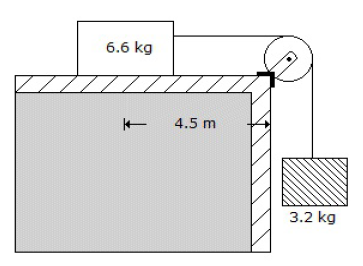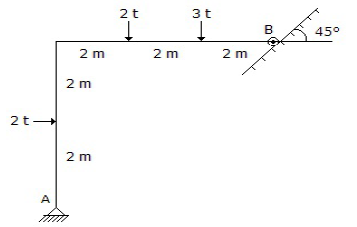When a body falls freely under gravitational force, it possesses
Maximum weight
Minimum weight
No weight
No effect on its weight
Correct Answer :
C. No weight
Related Questions
u1 and u2 are the velocities of approach of two moving bodies in the same direction and their corresponding velocities of separation are v1 and v2. As per Newton's law of collision of elastic bodies, the coefficient of restitution (e) is given by
e = v1 - v2/u2 - u1
e = u2 - u1/v1 - v2
e = v2 - v1/u1 - u2
e = v1 - v2/u2 + u1
One half of a vibration of a body, is called
Period time
Oscillation
Beat
Amplitude
A load of 500 kg was lifted through a distance of 13 cm. by an effort of 25 kg which moved through a distance of 650 cm. The efficiency of the lifting machine is
50 %
40 %
55 %
30 %
For the given values of initial velocity of projection and angle of inclination of the plane, the maximum range for a projectile projected upwards will be obtained, if the angle of projection is
α = π/4 - β/2
α = π/2 + β/2
α = β/2 - π/2
α = π/4 - β/2
A trolley wire weighs 1 kg per metre length. The ends of the wire are attached to two poles 20 m apart. If the horizontal tension is 1000 kg, the central dip of the cable is
2 cm
3 cm
4 cm
5 cm
Which one of the following laws is not applicable to a simple pendulum?
The time period does not depend on its magnitude
The time period is proportional to its length l
The time period is proportional to l, where l is length
The time period is inversely proportional to g, where g is the acceleration due to gravity
A retarding force on a body does not
Change the motion of the body
Retard the motion of the body
Introduce the motion of the body
None of these
P is the force acting on a body whose mass is m and acceleration is f. The equation P - mf= 0, is known as
Equation of dynamics
Equation of dynamic equilibrium
Equation of statics
None of these
One end of an elastic string of natural length / and modulus X is kept fixed while to the other end is attached a particle of mass m which is hanging freely under gravity. The particle is pulled down vertically through a distance x, held at rest and then released. The motion is
A simple harmonic motion
A rectilinear motion with constant speed
A damped oscillatory motion
None of the above
A body A of mass 6.6 kg which is lying on a horizontal platform 4.5 m from its edge is connected to the end of a light string whose other end is supporting a body of mass 3.2 kg as shown in below figure. If the friction between the platform and the body A is 1/3, the acceleration is 
0.5 m/sec2
0.75 m/sec2
1.00 m/sec2
1.25 m/sec2
The centre of gravity of a homogenous body is the point at which the whole
Volume of the body is assumed to be concentrated
Area of the surface of the body is assumed to be concentrated
Weight of the body is assumed to be concentrated
All the above
The angle of friction is:
The ratio of the friction and the normal reaction
The force of friction when the body is in motion
The angle between the normal reaction and the resultant of normal reaction and limiting friction
The force of friction at which the body is just about to move
Equation of motion of a point in a straight line, is
v = u + ft
S = ut + ½ ft2
2fS = v2 - u2
All the above
The displacement of a particle which moves along a straight line is given by S = 4t3 + 3t2- 10 where S is in meters and t is in seconds. The time taken by the particle to acquire a velocity of 18 m/sec from rest, is
½ sec
1 sec
1.2 sec
1.5 sec
A Seconds pendulum executes
0.5 beat per second
1.0 beat per second
2.0 beats per second
2.5 beats per second
The bending moment in an arch is proportional to
Vertical ordinate of funicular polygon
Vertical ordinate of the arch
Intercept between the arch axis and the funicular polygon
None of these
The reaction at the support B of the beam shown in below figure is 
1.6 t
9.6 t
8.5 t
0.5 t
The rate of change of displacement of a body with respect to its surrounding, is known
Velocity
Acceleration
Speed
None of these
The piston of a steam engine moves with a simple harmonic motion. The crank rotates 120 r.p.m. and the stroke length is 2 metres. The linear velocity of the piston when it is at a distance of 0.5 metre from the centre, is
5.88 m/sec
8.88 m/sec
10.88 m/sec
12.88 m/sec
Two forces of 6 Newtons and 8 Newtons which are acting at right angles to each other, will have a resultant of
5 Newtons
8 Newtons
10 Newtons
12 Newtons
To avoid bending action at the base of a pier,
Suspension and anchor cables are kept at the same level
Suspension and anchor cables are fixed to pier top
Suspension cable and anchor cables are attached to a saddle mounted on rollers on top of the pier
None the these
For a given velocity of a projectile, the range is maximum when the angle of projection is
30°
45°
90°
0°
When a body moves round a fixed axis, it has
A rotary motion
A circular motion
A translatory
A rotary motion and translatory motion
The following is in unstable equilibrium
A uniform solid cone resting on a generator on a smooth horizontal plane
A uniform solid cone resting on its base on a horizontal plane
A solid cube resting on one edge
A satellite encircling the earth
ω rad/sec is the angular velocity of a crank whose radius is r. If it makes θ° with inner dead centre and obliquity of the connecting rod l is , the velocity v of the piston, is given by the equation
ω2 (l cos + r sin tan θ)
ω2 (l sin + r cos φ tan θ)
ω (l sin + r cos tan θ)
ω2 (l sin - r cos θ tan )
On a mass m describing a circular path of radius r, the centrifugal force
Acts tangentially to the circular path
Acts towards the centre of rotation
Acts away from the centre of rotation
Is mw2r/g kgf
When two forces, each equal to P, act at 90° to each other, then the resultant will be
P
P√2
P/√2
2P
The unit of rotational inertia of a body in C.G.S system is
cm4
kg.cm²
gm.cm²
gm.cm3
A point subjected to a number of forces will be in equilibrium, if
Sum of resolved parts in any two directions at right angles, are both zero
Algebraic sum of the forces is zero
Two resolved parts in any two directions at right angles are equal
Algebraic sum of the moments of the forces about the point is zero
If a set of given forces are such that their free vectors build a closed polygon, then
The resultant force and resultant couple are always zero
The resultant force is zero but resultant couple is not zero
The resultant force is zero but resultant couple may not be zero
The resultant force and resultant couple both may not be zero
